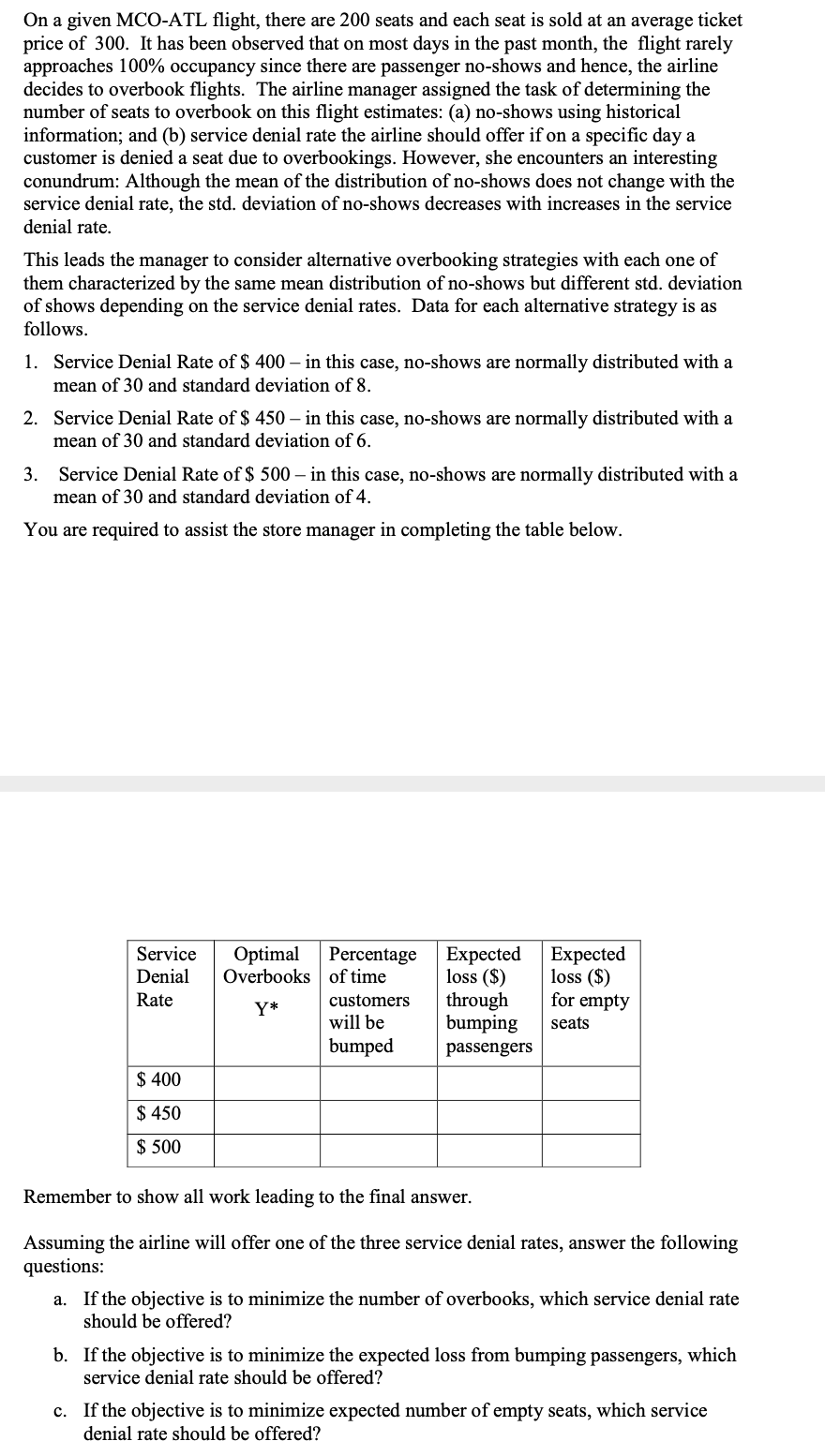
On a given MCO-ATL flight, there are 200 seats and each seat is sold at an average ticket price of 300. It has been observed that on most days in the past month, the flight rarely approaches 100% occupancy since there are passenger no-shows and hence, the airline decides to overbook flights. The airline manager assigned the task of determining the number of seats to overbook on this flight estimates: (a) no-shows using historical information; and (b) service denial rate the airline should offer if on a specific day a customer is denied a seat due to overbookings. However, she encounters an interesting conundrum: Although the mean of the distribution of no-shows does not change with the service denial rate, the std. deviation of no-shows decreases with increases in the service denial rate. This leads the manager to consider alternative overbooking strategies with each one of them characterized by the same mean distribution of no-shows but different std. deviation of shows depending on the service denial rates. Data for each alternative strategy is as follows. 1. Service Denial Rate of $ 400 in this case, no-shows are normally distributed with a mean of 30 and standard deviation of 8. 2. Service Denial Rate of $ 450 - in this case, no-shows are normally distributed with a mean of 30 and standard deviation of 6. 3. Service Denial Rate of $ 500 in this case, no-shows are normally distributed with a mean of 30 and standard deviation of 4. You are required to assist the store manager in completing the table below. Service Denial Rate Optimal Percentage Overbooks of time Y* customers will be bumped Expected loss ($) through bumping passengers Expected loss ($) for empty seats $ 400 $ 450 $ 500 Remember to show all work leading to the final answer. Assuming the airline will offer one of the three service denial rates, answer the following questions: a. If the objective is to minimize the number of overbooks, which service denial rate should be offered? b. If the objective is to minimize the expected loss from bumping passengers, which service denial rate should be offered? c. If the objective is to minimize expected number of empty seats, which service denial rate should be offered? On a given MCO-ATL flight, there are 200 seats and each seat is sold at an average ticket price of 300. It has been observed that on most days in the past month, the flight rarely approaches 100% occupancy since there are passenger no-shows and hence, the airline decides to overbook flights. The airline manager assigned the task of determining the number of seats to overbook on this flight estimates: (a) no-shows using historical information; and (b) service denial rate the airline should offer if on a specific day a customer is denied a seat due to overbookings. However, she encounters an interesting conundrum: Although the mean of the distribution of no-shows does not change with the service denial rate, the std. deviation of no-shows decreases with increases in the service denial rate. This leads the manager to consider alternative overbooking strategies with each one of them characterized by the same mean distribution of no-shows but different std. deviation of shows depending on the service denial rates. Data for each alternative strategy is as follows. 1. Service Denial Rate of $ 400 in this case, no-shows are normally distributed with a mean of 30 and standard deviation of 8. 2. Service Denial Rate of $ 450 - in this case, no-shows are normally distributed with a mean of 30 and standard deviation of 6. 3. Service Denial Rate of $ 500 in this case, no-shows are normally distributed with a mean of 30 and standard deviation of 4. You are required to assist the store manager in completing the table below. Service Denial Rate Optimal Percentage Overbooks of time Y* customers will be bumped Expected loss ($) through bumping passengers Expected loss ($) for empty seats $ 400 $ 450 $ 500 Remember to show all work leading to the final answer. Assuming the airline will offer one of the three service denial rates, answer the following questions: a. If the objective is to minimize the number of overbooks, which service denial rate should be offered? b. If the objective is to minimize the expected loss from bumping passengers, which service denial rate should be offered? c. If the objective is to minimize expected number of empty seats, which service denial rate should be offered







